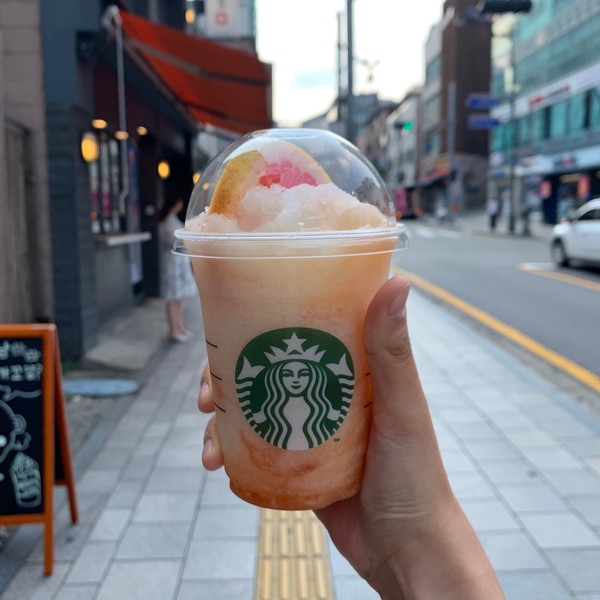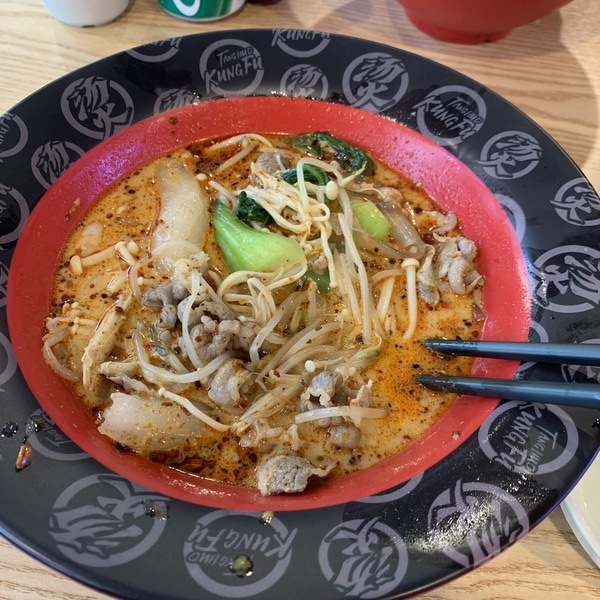
It's 15 minutes before noon. There are plenty of cafés and restaurants to choose from in front of Sookmyung Women's University. You call your friend to decide what to eat. "The waiting line is long here. Do you really want to eat Pho? If we run, we could get to that Malatang restaurant! Or would it be better just to eat tteokbokki? We have to decide soon or we'll not get a seat." After deciding on a place and eating, you and your friend then decide to grab dessert and a coffee. Two of you start discussing again. Will it be a cha with macarons? Or with bubble tea? A cup of coffee? The talk continues until it's decided that the two of you just grab coffee. Suddenly, the discussion is back on, but this time, you debate over which café to go to. What coffee shop will you visit?
Changes over Time
Commercial supremacy can be defined as the geographical area that can absorb the commercial activities of a store and the consumer activities of a customer. It is also referred to as a market area or hinterland. Commercial supremacy involves spaces where demand meets and approximately distributes purchasing power, and it typically is categorized into the following spaces: apartment complexes, university business districts, and bus/subway stations, dependent on their size. Each of these spaces varies greatly in scale and shape due to physical and psychological factors such as the type and means of transportation systems in the space. Therefore, an university business district, surrounding an university, meets the demands of student consumers. Recently, the public sectors near university business districts have become part of districts' consumer group, and it is growing to become a large part of the consumer group. University business districts have now become hubs of Seoul, with some of the bigger hubs like Shinchon, Hongdae, and Kondae. In 2018, Shinchon ranked the first in total university commercial sales with 73.5 billion won, followed by Hongdae with 62.2 billion won, and Kondae with 54.1 billion won in third place. In the case of Shinchon, roadside shops that sell beauty products are on the rise. Hongdae is becoming known for fashion, and Kondae is a magnet for restaurants.1) In other words, top ranking university commercial districts have adopted particular themes that make the areas have certain memorable images and attract certain types of consumers to the spaces.
The business district of Sookmyung Women's University has no single central theme. A good bus and subway infrastructure around the district are important, but at Sookmyung, there is a clear problem harming its commercial supremacy. The number of restaurants nearly equates to the small number of small shops in the area. There are more than five cafés, malatang stores, bubble tea shops, and tteokbokki eateries along the road from Sookmyung Women's University Station Line 4 to the front gate of the campus. It shows that if something is in vogue, there will be several of the same stores nearby. Moreover, there are only two banks, Shinhan Bank and MG Bank, in the area, making it inconvenient for customers who need access to a bank. The absence facilities in the area for live performances and movie-watching are additional problems. In other words, except for places to eat and drink, there is not much diversity in the area. Also, the restaurants in the area all tend to have similar menus.


Growing university business districts
After comparing Sookmyung Women's University's commercial district with those at other universities, findings show it lacks originality. Nevertheless, investigation of Sookmyungians’ satisfaction with Sookmyung's commercial district found 13.8% (9 students) said they were very satisfied, 50.8% (33 students) said it was satisfactory, 26.2% (17 students) said it was okay, 6.2% (4 students) said it was unsatisfactory, and 3.1% (2 students) said it was very unsatisfactory. These findings suggest that the majority of Sookmyungians, main consumers in the district, are satisfied with Sookmyung's commercial district. Factors of satisfaction were store hours and prices. According to the survey, 89.3% said they were happy with them, and 10.7% said they were very displeased with the store hours and prices. And when asked about prices, 89.2% said "cheap" or "ordinary", 10.7% said "expensive". Overall, the result shows that students are satisfied with the districts' businesses' hours and prices. On respondent, however, Moon Sunyu, Department of Political Science & International Relation '19 who spent a year living in the school dormitory said, "I felt the district to be a bit inconvenient because restaurants rarely open late at night. I had trouble if I finished work late to find a place to eat or grab a beverage." Another Sookmyungian, A, who lives near the library, said, "I have to eat out daily, but there is little variety I can choose from with a budget of less than 5,000 won. Also, it's a bit frustrating that I cannot get something to eat at night because the stores have closed their door early." While the survey indicated satisfaction, individual open-ended comments suggest otherwise.
Unlike the results above, respondents did have negative perceptions towards the types of businesses and the hygiene at eateries. When asked, "Do you think there are too many restaurants serving similar menus in front of the school?" more than half of the respondents (42 students) said 'yes', and 3.1% (2 students) said 'no'. Also, when asked about eatery sanitation and hygiene, 73.8% said they thought it was fine, 26.2% said it was awful. While satisfaction with the district is high, there is difference of opinion on menu diversity and hygiene satisfaction. Moreover, some respondents complained about pink tax. A real estate staff in the district said, "In the culture of individualism in Korea, women generally do not prefer drinking in group settings. Therefore, there are fewer of these related facilities in the business districts at women’s universities."2) This comment could be true given the number of beauty salons and cafés in the business districts of women's universities. Sookmyungian B said, "We should remove all stereotypes about women. Although perceptions are changing little by little, Korea still has a long way to go." Change and growth are needed in commercial districts surrounding women's universities.

Nothing is perfect
As mentioned earlier, some students are satisfied with the number of stores in front of Sookmyung, but others complained about some problems. The issues mentioned at Sookmyung are also presented at other universities districts in Seoul. Unlike frequently visited districts such as Hongdae, the shops in front of many universities rely on students to keep their businesses alive, so they feel a financial burden when school is out for summer and winter vacation. During the vacation periods, those without a competitive edge or those shops that do not attract enough customers do not last the two months periods. For this reason, many stores in front of Sookmyung Women's University and other universities open and close quickly. Other problems arise in front of Sookmyung. According survey results, about half of the 42 survey participants who answered the question: "What kinds of businesses would you like to see in the business district surrounding Sookmyung?", said they hoped "real" restaurants would open, not more snack bars. There were also large numbers of students who wanted a large SPA clothing store, a 24-hour café or restaurant, and a fast-food restaurant like McDonald's. Even though most students eat lunch and dinner near campus, their options for types of food and places to eat are limited.
In the survey, Sookmyungians were asked to suggest ways of improving the commercial district in front of Sookmyung. The top suggestions were to increase menu diversity and lower prices. Students hoped shops would consider selling items at more reasonable prices rather than being solely concerned with profits because ordinary undergraduates do not have a lot of extra money, so they must weigh the cost-effectiveness of products before purchasing them. Moreover, participants said they wish for more variety in the kinds of shops in the district, not more malatang restaurants and cafés. Some said that by mixing up the variety of shops, the shopkeepers themselves could ensure continued patronage during vacations and at weekends. The next most commonly voiced ideas dealt with sanitation. Sookmyung Women's University's Internet community (Snorose) often has postings that show unclean restaurants or cafés. One anonymous respondent in the survey said, "There are so many shops that are in need of great sanitation improvement. My friends and even acquaintances are reluctant to use those places fearing its poor level of hygiene." In November of last year, one restaurant in front of the school had two reported cases of hair being served in the food. It made a formal apology on the community board to the victim. Even with the apology, sales and patronage have plummeted due to a boycott of the restaurant. Students are very concerned about hygiene issues, so better constructive criticism by restaurant customers and owners is needed to ensure all are happy and satisfied.
What’s next?
The area in front of Sookmyung Women's University is not small to be known to people as a typical university district. Shops are continuously opening and then closing within a year of their opening. The shops need a fresh uniqueness, something not seen at other universities, if they wish to survive and capture the continued patronage of Sookmyungians. They need to meet the demands of their consumers, collaborate with their customers, and accept smooth feedback. Only once this is done will the district be reborn and lure people to the area in Seoul.
1) Kim Nahyun, "Growth in Commercial Districts Rise to 1st Place Beating Out Shinchon and Hongdae", Joongangilbo, November 1, 2018
2) Kim Semin, "Get Rid of Hair Salon and Café Stereotypes...Women's University Business Districts Are Evolving.", SEDAILY, March 9, 2020
Jung Kim Hyeseung / Society Section Editor
smt_jhs@sookmyung.ac.kr
Oh Hwang Junhee / Society Section Editor
smt_hjh@sookmyung.ac.kr


